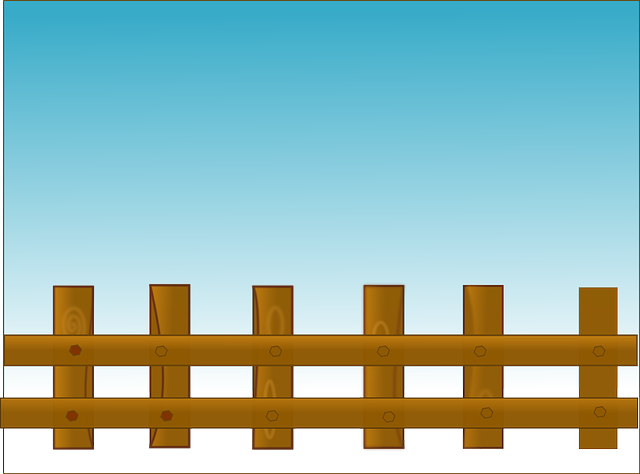In coastal regions, where harsh weather conditions and salty air pose unique challenges, selecting the right fencing material is paramount. This article explores durable wooden fencing as a superior solution for protecting properties along shorelines. We delve into the specific considerations, from understanding the demanding coastal environment to choosing resilient wood species and ensuring proper installation. Additionally, we provide maintenance tips and discuss the environmental benefits of sustainable fence options.
- Understanding Coastal Fencing Challenges
- Benefits of Durable Wooden Fencing
- Choosing the Right Wood Species
- Installation Considerations for Coastlines
- Maintenance Tips for Longevity
- Environmental Impact and Sustainability
Understanding Coastal Fencing Challenges
In coastal areas, fencing faces unique challenges due to exposure to harsh weather conditions, including salty air, strong winds, and regular fluctuations in temperature. Traditional materials often fail to withstand these elements, leading to frequent replacements and increased maintenance costs. The primary concern is finding a durable solution that can resist corrosion, maintain structural integrity, and retain its aesthetic appeal over time.
Wooden fencing, when treated appropriately, offers a promising alternative. It seamlessly blends with the coastal landscape and provides a natural barrier. However, selecting the right type of wood is crucial. Durable species like cedar or treated pine have proven effective against coastal conditions. Additionally, applying protective coatings and sealers can significantly enhance their resistance to moisture, salt, and UV radiation, ensuring these fences stand the test of time without compromising aesthetics or functionality.
Benefits of Durable Wooden Fencing
Durable wooden fencing offers an attractive and functional solution for coastal areas, where traditional materials may falter in the face of harsh weather conditions. One of its key advantages is aesthetics; wood provides a natural, classic look that enhances outdoor spaces, seamlessly blending with the surrounding environment. Unlike synthetic alternatives, wooden fences allow for customization, enabling homeowners to choose from various styles and designs, ensuring their unique coastal sanctuary remains distinctive over time.
Moreover, durable wood fencing is an environmentally friendly choice. It utilizes renewable resources, contributing to a reduced carbon footprint compared to other materials. The longevity of these fences also minimizes waste as they can be maintained and potentially reused or recycled at the end of their lifespan. This durability translates to lower maintenance costs for homeowners, ensuring their coastal investments stand the test of time against relentless winds, salty air, and varying weather patterns.
Choosing the Right Wood Species
When selecting wood for coastal fencing, choosing the right species is paramount to ensure longevity and durability. Softwoods like cedar and redwood are popular choices due to their inherent resistance to rot and pests. These woods also have a natural beauty that enhances outdoor spaces. However, for areas prone to high wind and salt exposure, harder woods such as oak or teak might be more suitable, despite being more expensive.
Consider the local climate and environmental factors when making your decision. Woods with higher density, like ipe or tropical hardwoods, offer superior durability against moisture and UV rays. Additionally, treating the wood with preservatives can further extend its lifespan, especially in harsh coastal conditions.
Installation Considerations for Coastlines
When installing wooden fencing in coastal areas, it’s crucial to consider the unique challenges posed by the environment. Salty air, strong winds, and moisture can significantly impact the longevity of materials. As such, selecting durable wood species like cedar or treated timber is essential for any fence designed to withstand these conditions. The installation process should also account for potential flooding or erosion, ensuring proper drainage and secure anchoring to prevent shifting during storms.
Additionally, choosing the right fencing design is vital. Consider low-profile options that aren’t as susceptible to catching strong winds, and incorporate features like angled posts or reinforced corners for added stability. Regular maintenance, such as re-sealing or painting, can further extend the fence’s life, protecting it from the relentless coastal elements.
Maintenance Tips for Longevity
To ensure your durable wooden fencing stands the test of time in coastal areas, regular maintenance is key. Start by cleaning the fence at least twice a year to remove salt spray and other debris that can accelerate wood decay. Use a soft-bristled brush and mild detergent for this task, avoiding harsh chemicals that could damage the finish.
After cleaning, apply a fresh coat of marine-grade sealant or paint designed for outdoor use. This protective layer shields the wood from moisture and UV rays, retarding rot and fading. Be sure to reapply every one to two years, depending on exposure and weather conditions, to maintain optimal protection.
